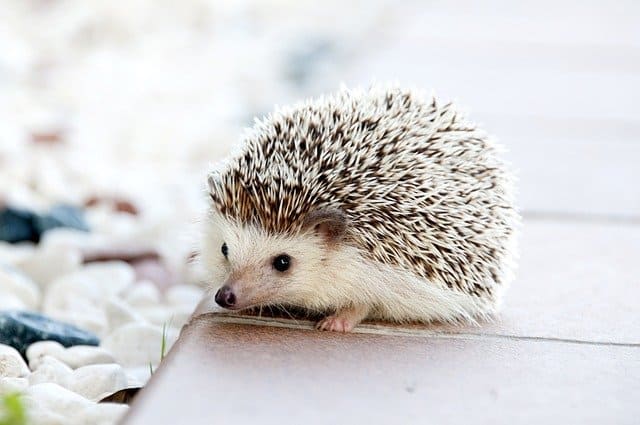
The hedgehog is famous for its prickly quills and an incredible defensive move that makes it truly special. In case of danger, in fact, his back muscles are activated in such a way as to allow him to roll up on himself and straighten all the spines until becoming almost invulnerable.
Not surprisingly, there is an old saying – ‘close up like a hedgehog’ – inspired by the extraordinary ability of this animal. Let’s get to know it better and discover its habits and rules for raising it at home or in the garden.
Just like moles, the hedgehog belongs to the order of insectivores , although its diet also includes invertebrates and small snakes.
The average duration of its life is 8-10 years . In nature it lives in a den dug into the ground , about 50 cm deep. It is its day shelter, as well as a bed in the winter months when the hedgehog hibernates .
The look is rather funny and nice. Its stocky , pear-shaped body, about 25-27 cm long for a weight that hardly reaches a kilogram. Equipped with a tail just 2.5 cm long, it has a rather long and pointed nose. The legs are short, stocky, with long feet and 5 toes with pointed nails.
Furthermore, each hedgehog has 6000 quills all over the body that change color depending on the season. In autumn and winter, the quills are brownish, in spring and summer they are decidedly lighter.
Reproduction
The hedgehog reaches sexual maturity around the first year of age. The mating season can be influenced by environmental factors such as climate and food availability, but usually occurs from April to September.
The courtship of hedgehogs is a very serious and complex ritual. In this long ceremony, which is not by chance also known as the ‘carousel of hedgehogs’, the male is not always accepted willingly by the female.
And while the mating itself lasts a few seconds, foreplay can take quite a long time. At the first shy approach of the male, the female reacts by blowing and snorting. Only after much insistence, the female lowers the quills and extends her legs to allow mating.
The reproduction takes place in summer with the female giving birth to the young between June and September after a gestation of 40 days. In some cases, two litters per year may occur, each of 3-6 pups. Even after weaning, the puppies will remain with their mother for several months.
The puppies are born without spines, naked, white and initially blind. Only after a few days the quills come out but become stiff and stinging after a month. And around 2-3 months they finally learn to roll up to defend themselves from predators.
Lethargy
The hedgehog is a mammal belonging to the Erinaceidae family and is also a nocturnal animal . A bit like the dormouse , it is a great sleeper, in fact during the day it sleeps even 12 hours straight. What not everyone knows is that it is also the only insectivore that hibernates in winter . At the first climatic variation, in fact, he realizes that the time has come to prepare for this long sleep.
The hibernation of the hedgehog is dictated by sensitive metabolic variations, but above all by the pituitary gland , the gland that stimulates the pancreas to produce insulin. This hormone, in turn, regulates the level of sugar in the blood which will guarantee the hedgehog a good reserve to survive during hibernation.
In autumn, not surprisingly, the hedgehog devotes himself to big binges just to better prepare himself for his long rest. It stocks up by stuffing the nest with supplies , accumulating leaves and dry grass to increase the internal temperature and prepare a comfortable bed.
From October to April he retires to his shelter, curls up nicely and sleeps almost continuously to wake up about once a month, just enough time for a snack.
What the hedgehog eats
As for nutrition , it is necessary to clearly distinguish what magic a country hedgehog from the recommended diet for a hedgehog kept in captivity. The first, in fact, lives in direct contact with nature and gets food especially at night.
In his case, the diet is mainly based on insects , earthworms, snails, spiders and millipedes. In the absence of this nourishment, it is also ‘satisfied’ with small reptiles and amphibians , such as frogs and toads. Being omnivorous, it also eats fruit , mushrooms, berries and acorns.
The diet of a ‘domestic’ hedgehog includes vegetables and meat. Remember, too, that hedgehogs love to nibble from the bowls of other animals, especially cats, as they love their treats, especially wet kibble.
With cats they tend to establish a relationship of peaceful coexistence. These two species live in a relationship of mutual respect and are not feared in the least. So if a feline lives in your home, the hedgehog will certainly appreciate his company and … his leftovers, while the dog may not like the presence of the hedgehog near his bowl as serenely.
Another thing that you will happen to notice, is to see the hedgehog loves chewing the leaves of your plants.
Yep, there’s nothing to do … if he runs into a succulent houseplant he could devour it in a short time. To prevent this from happening, move the plants to higher places, such as shelves and window sills, and offer the hedgehog salad leaves, spinach and other equally tender and tasty vegetables.
Beware of milk . Curls should never drink it, even though they love it. For them, milk represents a dietary excess that can cause even lethal intoxication .
Also avoid cold cuts and starchy foods that must never appear in its bowl.
How to raise a hedgehog
The first rule to observe in order to best raise a hedgehog at home is to remember that it is not just any pet, like a dog or a cat. Unlike the latter, in fact, the hedgehog is a rather reserved animal , which needs its spaces to live quietly and certainly does not like too ‘warm’ displays of affection.
The hedgehog is not even a cage animal . On the contrary, every now and then he must be left free to roam around the house or garden. In this sense, the African hedgehog is an exception because it is in effect an exotic animal. In his case it will be necessary to prepare a terraium in which to make him dwell, making sure that the temperature never drops below 20 ° .
Furthermore, the possession of this subspecies could be subject to restrictions, so it is important to verify that there are no legal impediments.
If the hedgehog you purchased comes from a certified breeding and has successfully passed the first vet visit , then you can start taking care of it.
A useful habit to encourage socialization with your new thorny friend is to hold him in your hand for a few minutes each day. This will allow the hedgehog to get used to your presence and smell and to gain confidence in you.
A bizarre habit that the animal will tend to manifest is that of salivating profusely . At least for the first time, in fact, it will react to the new situation by writhing, forming an ‘S’ with the body and anointing all its quills with saliva. And although the reasons for this behavior are unclear, the purpose is thought to be defensive , as the hedgehog’s saliva contains an irritant that makes its quills even more fearful.
Hedgehog in the garden
Even if you had never thought of raising a hedgehog as a pet, you have found one right in the backyard. What to do now?
In fact, he is quite a shrewd and opportunistic creature. If he finds a favorable environment in which to stabilize, he doesn’t think twice. And life in the garden seems to like it very much.
A peaceful and serene coexistence in a place frequented by humans and perhaps other animals is possible, provided that some precautions are adopted .
This cute little spinosetto will greatly appreciate the presence of leaves and hiding places in which to take refuge, but to make his stay even easier it will be essential not to make him lack a good source of clean water .
Normally he drinks from the puddles that form with rainwater, so in the absence of natural water sources it will be better to prepare a small bowl of water that you will change every day.
Pay attention to the size of the container: if you use pans that are too large or dry, the little guy could fall into them!
Remember that the hedgehog is a nocturnal animal . In fact, when darkness falls, he goes out in search of food, while during the day he prefers to hole up in a quiet and cool place.
If in your garden there are no natural crevices favorable to this habit, create one! Just a small hole protected by leaves or twigs, for example, and for sure you will make him happy.
Finally, remember that the hedgehog is an ecological animal . Feeding on insects and plant parasites, your garden will not need chemicals to keep these unwelcome guests at bay because your little friend will think about it.






